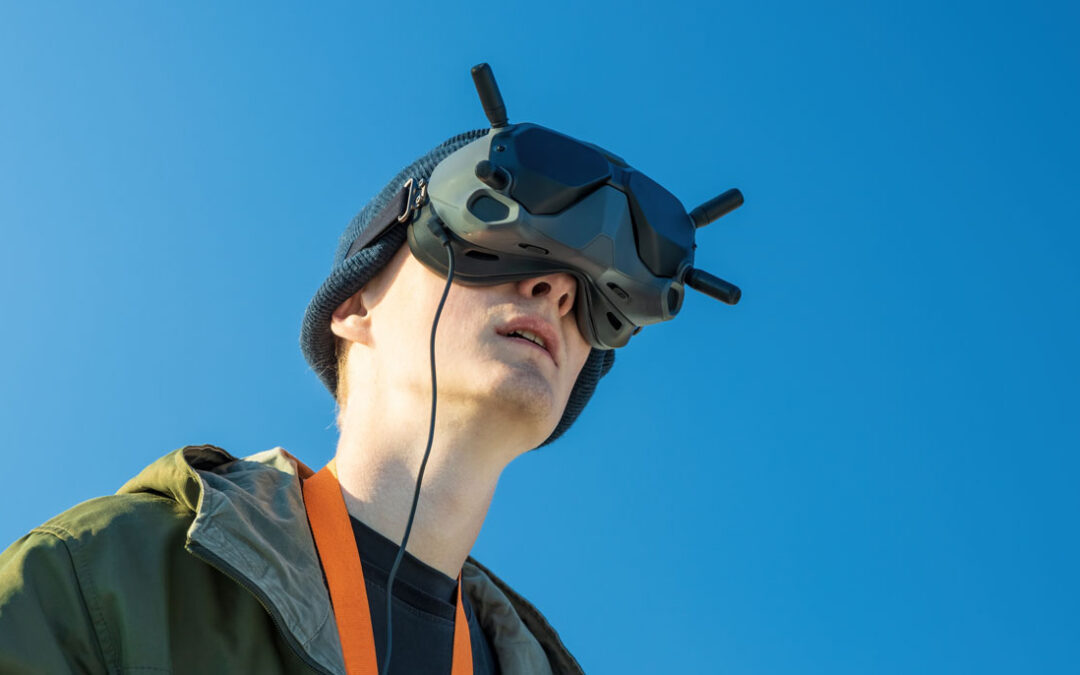An FPV drone is simply a drone that gives the pilot a “first-person view” of what the drone sees. These smaller, highly maneuverable drones have taken the drone community by storm, enabling pilots to engage in exciting racing activities and create mind-blowing cinematic video that has never been possible before on the screen. At Rocket Drones, our FPV racing drones are at the core of our educational program. In this article, we will discuss how FPV drones are different from traditional aerial photography drones and dive a little deeper into the world of FPV.
A Totally Immersive Experience
Drone pilots wear a pair of special goggles to be able to fly an FPV drone. With traditional aerial photography drone platforms, pilots use line of sight vision to pilot their drone paired with the controller display to see through the camera lens. FPV drones put you in the cockpit of the drone, giving the pilot a completely immersive experience that is similar to what virtual reality offers. While this can be advantageous for several reasons, it does pose some potential hurdles for pilots. For example, it’s usually best practice for FPV drone pilots to have spotters available since their vision is completely blocked from the physical world around them. Additionally, some pilots who are used to traditional drone controls may struggle initially to adapt to the on-board view that an FPV system offers.
FPV Drones Are Extremely Maneuverable
Maneuverability has been one of the major selling points for FPV drones. Traditional aerial drones are designed to hover in place and prioritize stability, panning smoothly and slowly to get into position. On the other hand, FPV drones can fly at much higher speeds and be maneuvered around tight twists and turns with precision and accuracy. (You might remember this bowling alley video that went viral using an FPV drone that showcased its precision capabilities in a small, indoor space.) The enhanced maneuverability set the stage for competitive drone racing leagues across the world. Rocket Drones uses FPV drone technology to engage middle school and high school students with drone racing. To learn more about how we can bring a racing league to your school, visit our drone racing kits for schools page.
Learning to Pilot an FPV Drone Takes Time
With enhanced maneuverability, FPV drone piloting requires a different skill set that is separate from traditional aerial drones. While most seasoned drone pilots are able to adapt quicker than those who are new to drones altogether, the barrier to entry to become a skilled FPV pilot is significant. For example, FPV drones require more manual inputs from the pilot with less stabilizing features than a traditional drone. While this makes for a much higher learning curve, it also enables the pilots to have more control than ever before. There are also major adjustments drones pilots will have to make when working with this smaller, more agile platform. One of those adjustments is shortening flight time drastically. It’s not uncommon for a traditional aerial drone to be functional for upwards of 30 minutes on a single battery charge. For an FPV platform, pilots should expect to have to swap out batteries in as little as 8 to 10 minutes on a single charge. The reason for this is that powerful motors are necessary to propel these smaller FPV drones up to super high speeds, meaning more battery power is needed and flight time is limited. Less time in the air per charge means that the margin for error shrinks and mistakes are more costly when your project time is precious.
FPV Drones Aren’t As Applicable in the Commercial Drone Industry
FPV drones have unlocked the thrill of drone racing and cinematic moments for film. However, the money-making applications still lean heavily in favor of the standard aerial photography drone system. The simple fact is that FPV drones, in most cases, are not as practical for the overwhelming majority of situations that require a UAV. This means that people who want to make a living in the drone industry should not plan on hanging up the controls on their traditional platforms. Photography, mapping, security, agriculture, and more are still grossing the highest pay for drone operators. While FPV drone pilots are still paid very well for their work, those jobs are highly competitive and sought after. If you want to learn more about how you can make the most money in the drone industry, read our How Much Does a Drone Operator Make article.
The Rocket Drones FPV Experience
If the learning curve for FPV drone piloting is steep, why not introduce it early to kids when their learning ability and information retention is at its highest? Rocket Drones’ student racing program is a comprehensive educational package designed to introduce students to drone technology, physics, engineering, and computer science. This unique approach to learning not only cultivates technical skills but also enhances problem-solving abilities, teamwork, and creativity. Furthermore, it introduces the students to FPV drones and the goggles so that they enter the workforce with the skills necessary for both FPV and traditional aerial photography drones, giving them a leg up on their peers. If you’re ready to take the next step with Rocket Drones at your school, learn more about it and get in touch with us on our curriculums page.

